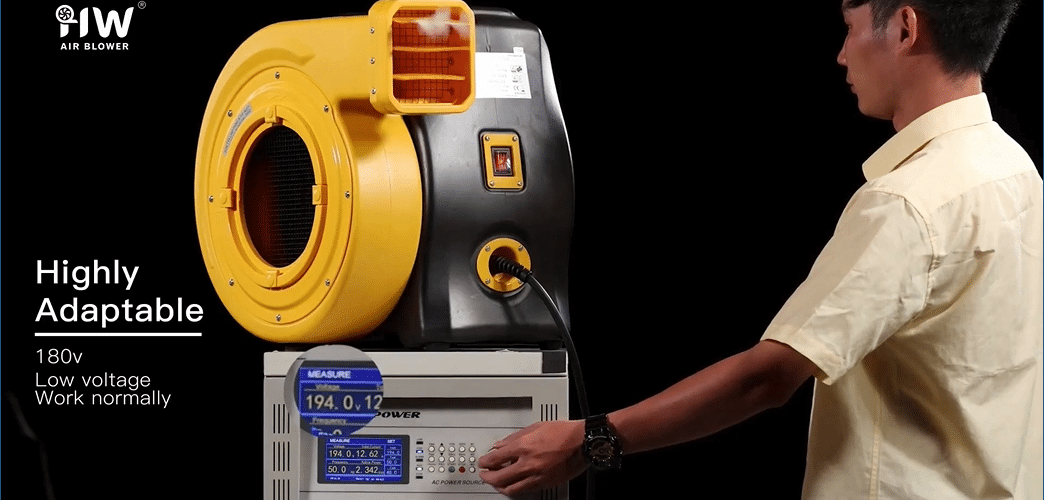
How to Maintain Optimal Airflow for Different Inflatable Types Using Huawei Blowers
Ensuring consistent, optimal airflow is essential for keeping inflatables safely inflated and providing a stable experience for event guests. Huawei air blowers offer versatile solutions for different inflatable types, but maintaining ideal airflow for each setup requires attention to blower placement, monitoring, and choosing the right model. Here’s how to achieve and maintain optimal airflow for various inflatable types using Huawei blowers.
1. Choose the Right Huawei Blower Model for Each Inflatable
Each inflatable type has unique airflow needs based on size, material, and structure. Using a blower with suitable power for the inflatable helps maintain steady airflow and prevents underinflation or excessive strain on the blower.
Recommended Models for Different Inflatables
- Eco-1000: Ideal for small inflatables like bounce houses or advertising inflatables, where moderate airflow is sufficient.
- HP-1200: Suited for medium inflatables, such as large bounce houses or inflatable tents, providing a balance between power and efficiency.
- HP-1600 Pro: Best for large inflatables, such as obstacle courses and giant slides, delivering high airflow for quick inflation and steady pressure.
2. Position the Blower Correctly
The placement of the blower affects airflow efficiency and inflatable stability. Ensure the blower is positioned on a stable, flat surface, close to the inflatable’s intake valve. A direct connection minimizes airflow loss, while incorrect positioning can lead to reduced air pressure.
Blower Placement Tips
- Secure Connection: Attach the blower securely to the inflatable’s intake valve to prevent air leaks and ensure maximum airflow.
- Clear Obstructions: Ensure the intake vents and hose are free of kinks, twists, or blockages that could restrict airflow.
- Stable Surface: Place the blower on a stable, level surface to avoid tipping or vibrations that may interfere with airflow.
3. Monitor Airflow During Operation
Monitoring the airflow ensures the inflatable remains properly inflated throughout the event. Check the blower and inflatable periodically to ensure consistent pressure, especially if the blower is running for extended periods.
Monitoring Tips
- Check for Air Leaks: Periodically inspect the inflatable and blower connection for leaks that may cause deflation.
- Adjust as Needed: If you notice sagging in the inflatable, ensure that the blower is running at full capacity and connections are secure.
- Listen for Unusual Sounds: Unusual sounds may indicate an issue with the blower’s motor or airflow restriction; address these immediately to avoid interruptions.
4. Use the Correct Extension Cord
If your blower needs to be placed at a distance from a power source, using a suitable extension cord ensures steady power delivery and optimal blower performance. Select a heavy-duty, outdoor-rated extension cord to handle the power requirements of your Huawei blower without voltage drops.
Extension Cord Tips
- High-Gauge Cords: Use a 12-gauge or 14-gauge cord for medium to large blowers to avoid power loss and maintain steady airflow.
- Outdoor Rated: For outdoor setups, choose a cord designed for outdoor use to withstand environmental conditions and prevent overheating.
5. Adjust for Weather Conditions
Weather conditions like wind, rain, or high temperatures can affect blower performance and inflatable stability. Take preventive steps to maintain optimal airflow and safe operation in various weather scenarios.
Weather Adaptation Tips
- Windy Conditions: Position the blower to provide steady airflow to compensate for any pressure changes caused by the wind, and use additional stakes or weights to secure the inflatable.
- Hot Weather: In high temperatures, check the blower periodically to avoid overheating, and place it in a shaded area if possible.
- Wet Conditions: Use waterproof covers for both the blower and any exposed cords, and avoid placing the blower in direct contact with wet ground.
6. Regularly Clean and Maintain Your Blower
Routine maintenance, such as cleaning the air intake and inspecting the blower’s components, keeps it running efficiently and prevents airflow issues during events.
Maintenance Tips for Optimal Airflow
- Clear Intake Vents: Dust and debris can clog the intake vents, reducing airflow. Clean the vents regularly to maintain proper air intake.
- Inspect for Damage: Check hoses, power cords, and the blower’s body for wear or damage that could affect performance.
- Lubricate Moving Parts: If recommended by the manufacturer, apply lubrication to keep parts running smoothly and quietly.
Ensure Reliable Airflow for Every Inflatable Type
By selecting the correct Huawei blower model, monitoring airflow, positioning the blower properly, and performing routine maintenance, you can achieve and maintain optimal airflow for various inflatable types. These practices ensure stable, reliable inflation for every event, creating a safe and enjoyable experience for all participants.
Implement these best practices to maximize your Huawei air blower’s efficiency and ensure seamless operation across different inflatables!